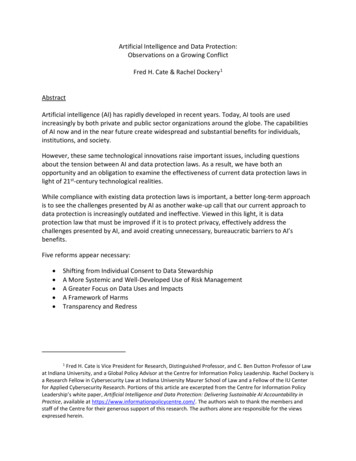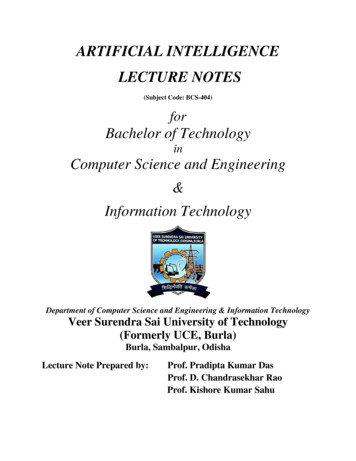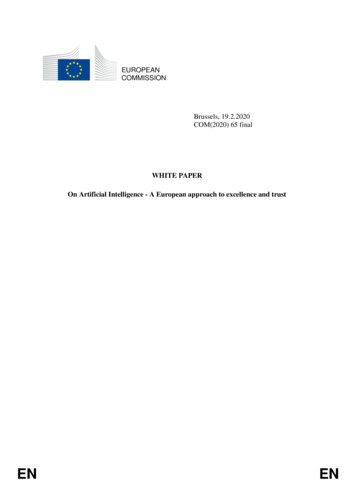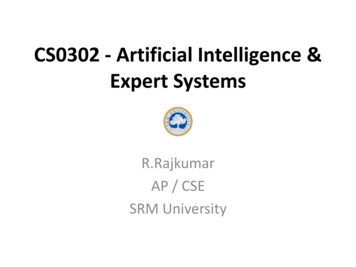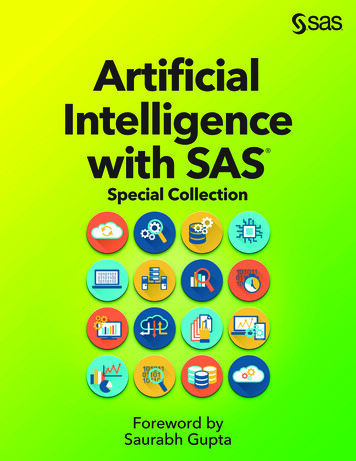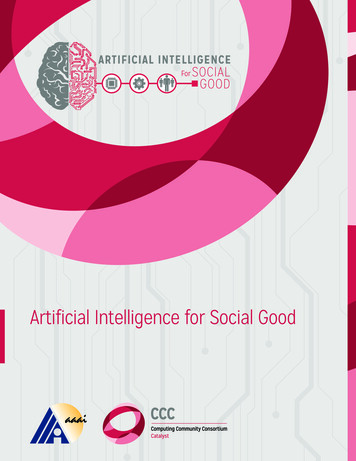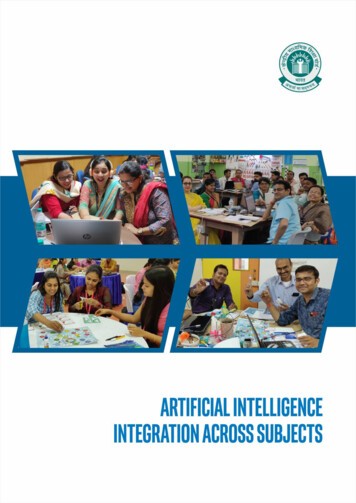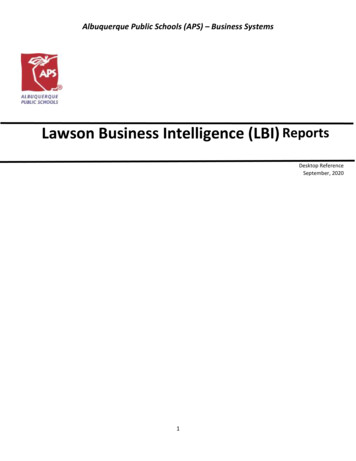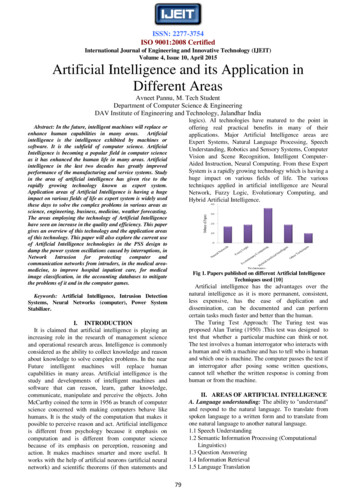
Transcription
ISSN: 2277-3754ISO 9001:2008 CertifiedInternational Journal of Engineering and Innovative Technology (IJEIT)Volume 4, Issue 10, April 2015Artificial Intelligence and its Application inDifferent AreasAvneet Pannu, M. Tech StudentDepartment of Computer Science & EngineeringDAV Institute of Engineering and Technology, Jalandhar Indialogics). AI technologies have matured to the point inoffering real practical benefits in many of theirapplications. Major Artificial Intelligence areas areExpert Systems, Natural Language Processing, SpeechUnderstanding, Robotics and Sensory Systems, ComputerVision and Scene Recognition, Intelligent ComputerAided Instruction, Neural Computing. From these ExpertSystem is a rapidly growing technology which is having ahuge impact on various fields of life. The varioustechniques applied in artificial intelligence are NeuralNetwork, Fuzzy Logic, Evolutionary Computing, andHybrid Artificial Intelligence.Abstract: In the future, intelligent machines will replace orenhance human capabilities in many areas.Artificialintelligence is the intelligence exhibited by machines orsoftware. It is the subfield of computer science. ArtificialIntelligence is becoming a popular field in computer scienceas it has enhanced the human life in many areas. Artificialintelligence in the last two decades has greatly improvedperformance of the manufacturing and service systems. Studyin the area of artificial intelligence has given rise to therapidly growing technology known as expert system.Application areas of Artificial Intelligence is having a hugeimpact on various fields of life as expert system is widely usedthese days to solve the complex problems in various areas asscience, engineering, business, medicine, weather forecasting.The areas employing the technology of Artificial Intelligencehave seen an increase in the quality and efficiency. This papergives an overview of this technology and the application areasof this technology. This paper will also explore the current useof Artificial Intelligence technologies in the PSS design todamp the power system oscillations caused by interruptions, inNetwork Intrusion forprotecting computerandcommunication networks from intruders, in the medical areamedicine, to improve hospital inpatient care, for medicalimage classification, in the accounting databases to mitigatethe problems of it and in the computer games.Fig 1. Papers published on different Artificial IntelligenceTechniques used [10]Artificial intelligence has the advantages over thenatural intelligence as it is more permanent, consistent,less expensive, has the ease of duplication anddissemination, can be documented and can performcertain tasks much faster and better than the human.The Turing Test Approach: The Turing test wasproposed Alan Turing (1950) .This test was designed totest that whether a particular machine can think or not.The test involves a human interrogator who interacts witha human and with a machine and has to tell who is humanand which one is machine. The computer passes the test ifan interrogator after posing some written questions,cannot tell whether the written response is coming fromhuman or from the machine.Keywords: Artificial Intelligence, Intrusion DetectionSystems, Neural Networks (computer), Power SystemStabilizer.I. INTRODUCTIONIt is claimed that artificial intelligence is playing anincreasing role in the research of management scienceand operational research areas. Intelligence is commonlyconsidered as the ability to collect knowledge and reasonabout knowledge to solve complex problems. In the nearFuture intelligent machines will replace humancapabilities in many areas. Artificial intelligence is thestudy and developments of intelligent machines andsoftware that can reason, learn, gather knowledge,communicate, manipulate and perceive the objects. JohnMcCarthy coined the term in 1956 as branch of computerscience concerned with making computers behave likehumans. It is the study of the computation that makes itpossible to perceive reason and act. Artificial intelligenceis different from psychology because it emphasis oncomputation and is different from computer sciencebecause of its emphasis on perception, reasoning andaction. It makes machines smarter and more useful. Itworks with the help of artificial neurons (artificial neuralnetwork) and scientific theorems (if then statements andII. AREAS OF ARTIFICIAL INTELLIGENCEA. Language understanding: The ability to "understand"and respond to the natural language. To translate fromspoken language to a written form and to translate fromone natural language to another natural language.1.1 Speech Understanding1.2 Semantic Information Processing (ComputationalLinguistics)1.3 Question Answering1.4 Information Retrieval1.5 Language Translation79
ISSN: 2277-3754ISO 9001:2008 CertifiedInternational Journal of Engineering and Innovative Technology (IJEIT)Volume 4, Issue 10, April 2015B. Learning and adaptive systems: The ability to adaptIII. APPLICATIONS OF ARTIFICIALbehavior baged on previous experience, and to developINTELLIGENCEgeneral rules concerning the world based on suchA. Application of Artificial Intelligent Techniques inexperience.Power system stabilizers (PSSs) Design2.1 CyberneticsSince the 1960s, PSSs have been used to add damping2.2 Concept Formationto electromechanical oscillations. The PSS is anadditional control system, which is often applied as a partC. Problem solving: Ability to formulate a problem in aof an excitation control system. The basic function of thesuitable representation, to plan for its solution and toPSS is to apply a signal to the excitation system,know when new information is needed and how to obtainproducing electrical torques to the rotor in phase withit.speed differences that damp out power oscillations. They3.1 Inference (Resolution-Based Theorem Proving,perform within the generator‟s excitation system to createPlausible Inference and Inductive Inference)a part of electrical torque, called damping torque,3.2 Interactive Problem Solvingproportional to speed change. A CPSS can be modeled by3.3 Automatic Program Writinga two stage (identical), lead-lag network which is3.4 Heuristic Searchrepresented by a gain K and two time constants T1 andT2. This network is connected with a washout circuit of aD. Perception (visual): The ability to analyze a sensedtime constant Tw. The signal washout block acts as ascene by relating it to an internal model which representshigh-pass filter with the time constant Tw that allows thethe perceiving organism's "knowledge of the world." Thesignal associated with the oscillations in rotor speed toresult of this analysis is a structured set of relationshipspass unchanged. Furthermore, it does not allow thebetween entities in the scene.steady state changes to modify the terminal voltages. The4.1 Pattern Recognitionphase compensation blocks with time constants T1i – T4i4.2 Scene Analysissupply the suitable phase-lead characteristics tocompensate the phase lag between the input and theE. Modeling: The ability to develop an internaloutput signals. The commonly used structure of the PSSrepresentation and set of transformation rules which canis shown in Fig [10].be used to predict the behavior and relationship betweensome set of real-world objects or entities.5.1 The Representation Problem for Problem SolvingSystems5.2 Modeling Natural Systems (Economic, Sociological,Ecological, Biological etc.)Fig 2. Structure of PSS [10]5.3 Hobot World Modeling (Perceptual and FunctionalIn the field of power system operation computerRepresentations)programs are executed and modified frequently accordingto any variations. Artificial intelligence (AI) has theF. Robots: A combination of most or all of the aboveability to deal with the high non-linearity of practicalabilities with the ability to move over terrain andSystems. The various technologies that are used in PSSsmanipulate objects.optimization problems are ANN, FL, ES etc.6.1 Exploration6.2 Transportation/Navigation1.1) Artificial Neural Network (ANN) in PSS: In the6.3 Industrial Automation (e.g., Process Control,power systems the most applications of the artificialAssembly Tasks, Executive Tasks)neural network use a multilayer feed forward network. In6.4 Securitythe neural adaptive PSS, a feed-forward neural network6.5 Other (Agriculture, Fishing, Mining, Sanitation,with a single hidden layer is proposed which includes twoConstruction, etc.)sub networks: adaptive neuro-identifier, in which the6.6 Militarydynamic characteristics of the plant are tracked and6.7 Householdadaptive neurocontroller to damp the low frequencyoscillations. Radial basis function network (RBFN) hasG. Games: The ability to accept a formal set of rules forthree layers: input layers, hidden layers, and outputgames such as Chess, Go, Kalah, Checkers, etc., and tolayers. The hidden layer find centers and widths of thetranslate these rules into a representation or structureradial basis functions for individual pattern units and thewhich allows problem-solving and learning abilities to beoutput layer finds the weights between the pattern unitsused in reaching an adequate level of performance.and the output units using an unsupervised learning7.1 Particular Games (Chess, Go, Bridge, etc.) [11]algorithm. A recurrent neural network (RNN)stabilization controller is proposed to improve the80
ISSN: 2277-3754ISO 9001:2008 CertifiedInternational Journal of Engineering and Innovative Technology (IJEIT)Volume 4, Issue 10, April 2015transient stability of power systems in which both theand TCP dump raw data. The data set contains 24 attackgovernor and AVR is used. The weight of the proposedtypes. The attacks fall into four main categories viz.controller is adjusted on-line. The signal output of theDenial of Service (DOS), Remote to User (R2L), User tofirst RNN is added to the PSS signal output for excitationRoot (U2R), and Probing. From the results, it was showncontrol. The signal output of the second RNN is used as athat the Fuzzy Inference System was faster in training,stabilizing signal for the governor system. ANNs aretaking few seconds, than the Artificial Neural Networksintelligent controllers to control nonlinear, dynamicwhich took few minutes to converge. Generally, bothsystems through learning, which can easily accommodatetechniques proved to be good, but with the Fuzzythe nonlinearities and time dependencies.Inference System having an edge over Artificial NeuralNetworks with its higher classification accuracies. Their1.2) Fuzzy Logic (FL) in PSS: In 1964, Lotfi Zadehexperiment also showed the importance of variabledeveloped FL to address inaccuracy and uncertaintyselection, as the two techniques performed worse whenwhich usually exist in engineering problems [10]. Aall the variables were used without selection of thedesign process for a fuzzy logic based PSS (FLPSS) wasvariables. Good results were recorded when a subsetproposed for a multi-machine power system. The input(about 40%) of the variables were used [12].signal to FLPSS is the speed deviation of the synchronousgenerator and its derivative. For the robustness of thec) Application of Artificial Intelligence Techniques inFLPSS, five generator power systems were used and forMedical Areadesigning a normalized sum-squared deviation indexArtificial intelligence techniques have the potential towere used. This A novel input signal based FLPSS wasbe applied in almost every field of medical area.applied in the multi-machine environment.3.1) Artificial Intelligence in Medicine3.1.1) Fuzzy Expert Systems in Medicine: Fuzzy logicis a data handling methodology that permits ambiguityB) Application of Artificial Intelligence Techniques inand hence is particularly suited to medical applications. ItNetwork Intrusion DetectionIntrusion Detection Systems (IDS) uses the variouscaptures and uses the concept of fuzziness in aArtificial Intelligence techniques for protecting computercomputationally effective manner. The most likely area ofand communication networks from intruders. Intrusionapplication for this theory lies in medical diagnostics and,Detection System (IDS) is the process of monitoring theto a lesser extent, in the description of biologicalevents occurring in network and detecting the signs ofsystems[14].Fuzzy expert systems use the structure of aintrusion.series of „if – then‟ rules for modeling.2.1) Artificial Neural Network in IDS: ANN is amathematical model that consists of an interconnectedgroup of artificial neurons which processes theinformation. In IDS ANN are used to model complexrelationships between inputs and outputs or to findpatterns in data. In this a neuron calculates the sum bymultiplying input by weight and applies a threshold. Theresult is transmitted to subsequent neurons. Basically, theANN has been generalized to: [6]Fig 3. A typical fuzzy rule system. [1]The techniques of fuzzy logic have been explored inmany medical applications. Fuzzy logic is preferred overthe multiple logistic regression analysis in diagnosinglung cancer using tumour marker profiles. Fuzzy logic isalso used in the diagnosis of acute leukaemia and breastand pancreatic cancer and also predict patients‟ survivalwith breast cancer. They can also characterize MRIimages of brain tumours ultrasound images of the breast,ultrasound. Fuzzy logic controllers have been designedfor the administration of vasodilators in the peri-operativeperiod to control blood pressure.yi f( wikxk µi)(1)kWhere wik are weights attached to the inputs, xk areinputs to the neuron i, μi is a threshold, f ( ) is a transferfunction and yi is the output of the neuron.2.2) Fuzzy Inference Systems (FIS) in IDS: Sampadaet al [12] proposed two machine learning paradigms:Artificial Neural Networks and Fuzzy Inference System,for the design of an Intrusion Detection System. Theyused SNORT to perform real time traffic analysis andpacket logging on IP network during the training phase ofthe system. They constructed a signature pattern databaseusing Protocol Analysis and Neuro-Fuzzy learningmethod. They then tested and validated the models usingthe 1998 DARPA Intrusion Detection Evaluation Data3.1.2) Evolutionary Computation in Medicine:Evolutionary computation is the general term for severalcomputational techniques based on natural evolutionprocess that imitates the mechanism of natural selectionand survival of the fittest in solving real-world problems.The most widely used form of evolutionary computationfor medical applications are „Genetic Algorithms‟ [8].„Genetic Algorithms‟ based on the natural biological81
ISSN: 2277-3754ISO 9001:2008 CertifiedInternational Journal of Engineering and Innovative Technology (IJEIT)Volume 4, Issue 10, April 2015evolution are the most widely used form of evolutionarydimensional classification method was proposed. Thiscomputation for medical applications. The principles ofmethod had good time consuming rate and classificationGenetic algorithms have been used to predict outcome inaccuracy. Another intelligent classification techniquecritically ill patients. MRI segmentation of brain tumoursproposed was Least Squares Support Vector Machinesto measure the efficacy of treatment strategies is also(LS-SVM). It identifies normal and abnormal slices ofdone through evolutionary computation. They have alsobrain MRI data. This technique had a higher accuracy ofbeen used in computerized analysis of mammographicclassification over other classifiers as the false negative inmicro calcification.LS-SVM was very low compared. Due to automaticdefects detection in MR images of brain, extensiveresearch is being performed.3.2) Using Artificial Intelligence to Improve HospitalInpatient Care: Clinical decision support systems(CDSS) were one of the first successful applications ofD) Application of Artificial Intelligence inAI, focusingAccounting Databases:Primarily on the diagnosis of a patient‟s conditionThe use of artificial intelligence is investigated as thegiven his symptoms and demographic informationbasis to mitigate the problems of accounting databases.[4].Mycin a rule-based expert system for identifyingThe following are some difficulties with existingbacteria causing infections and recommending antibioticsaccounting database systems.to treat these infections was developed in 1970 under theThe needs of decision makers are not met bywork of CDSS for medical diagnosis. Pathfinder, whichaccounting information. Humans do not understand orused Bayesian networks to help pathologists morecannot process the computerized accounting databases.accurately diagnose lymph-node diseases. AI has alsoSystems are not easy to use. There is focus on thebeen useful for computer-aided detection of tumors innumeric data.medical images. Such approaches help in the diagnosis ofIntegrating intelligent systems with accountingvarious forms of cancer, and congenital heart defects.databases can assist (either with the decision maker orindependent of decision maker) in the investigation oflarge volumes of data with or without direct participation3.3) Artificial Intelligence Approaches for MedicalImage Classification: Artificial intelligence techniquesof the decision maker. Thus, the systems can analyze theare used for diagnostic sciences in biomedical imagedata and assist the users understanding or interpretingclassification. Model-based intelligent analysis andtransactions to determine what accounting events aredecision-support tools are important in medical imagingcaptured by the system [5].With the artificial intelligencefor computer-assisted diagnosis and evaluation. CADwe store and retrieve knowledge in natural language.helps radiologist who uses the output from aThere are some artificial intelligence tools or techniquescomputerized analysis of medical images as a secondthat help in the broader understanding of events capturedopinion in detecting lesions, assessing extent of disease,by the accounting system. There is more emphasis onand improving the accuracy and consistency ofsymbolic or text data rather than just numeric data toradiological diagnosis to reduce the rate of false negativecapture context. The artificial intelligence and expertcases [12].system builds intelligence into the database to assistusers. Without users direct participation such models helpthe users by sorting through large quantities of data. Such3.3.1) Artificial Neural Networks Approach onDiagnostic Science: The following subsections willmodels also assist the decision makers under timediscuss how ANN is utilized for image classification overconstraints; suggest alternatives in the searching andgenerations.evaluation of data.3.3.1.1) Endoscopic Images: Image classification is animportant step in CAD. In classification of endoscopicimages a hybrid implementation by advanced fuzzyinference neural network which combines fuzzy systemsand Radial Basis Function (RBF) was proposed. Theconcept of fusion of multiple classifiers dedicated tospecific feature parameters with an accuracy of 94.28%but RBF was characterized by a very fast training ratethan fuzzy. It extracted both texture and statisticalfeatures [13].E) Application of Artificial Intelligence Techniquesin the Computer GamesPlaying games is one of the most popular uses forcomputer technology. In the evolution of computergames, they have grown from modest text based to thethree dimensional graphical games with complex andlarge worlds. The systems as graphics rendering, playingaudio, user input and game artificial intelligence (AI)when put together provide the expected entertainment andmake a worthwhile computer game. Artificial intelligenceis the most important part of every computer game andplaying the game without artificial intelligence would notbe any fun!. If we remove artificial intelligence fromcomputer games, the games will be so simple that nobody3.3.1.2) MRI Brain Tumour AnalysisFor the MRI brain tumour images a general regressionneural network (GRNN) based automatic three-82
ISSN: 2277-3754ISO 9001:2008 CertifiedInternational Journal of Engineering and Innovative Technology (IJEIT)Volume 4, Issue 10, April 2015will be interested in playing the computer gamesi. If so, check whether the new path is moreanymore!. Without the game AI, the winning would notefficient (lower f-value).be difficult at all. Artificial intelligence is used to solve1. If so, update path.common problems in the computer games and provide theii. Else, add C to open list.features to the games. Specifically, non-playing characterc. Repeat step 5 for all valid children of B.(NPC) path finding, decision making and learning are6. Move B from the Open list to the closed list andexamined. There are several ways that AI contributes torepeatmodern computer games. Most notably are unitFrom step 4.[9]movement, simulated perception, situation analysis,spatial reasoning, learning, group coordination, resource5.2) NPC Decision Making Using Bayesian Networksallocation, steering, flocking, target selection, and soIn the previous example of the monster negotiating amany more. Even context dependent animation and audiopath to the player, a different problem must be solveduse AI [2].first before negotiating the path. The problem is does theComputer Game Problems Solved with AI: Artificialmonster even know the player is present in the building?intelligence solves the three common problems: nonIf the game designers give the full information of theplaying character (NPC) movement, NPC decisiongame world to the non-playing character then there wouldmaking, and NPC learning. The four artificial intelligencebe no fun in playing the game. This is an example of NPCtechniques used are Path Finding, Bayesian Networks,Decision making. In this AI is needed to make the nonFuzzy Logic, and Genetic Algorithms which help aplaying character to act in a human like way. When thecomputer game provide non-playing character pathplayer enters the building from the other side, the monsterfinding and decision making as well as learning.will be unaware of the presence of the player because ofthe wall between them. If the player enters causing anoise disturbance, then the monster will sense the player5.1) NPC Movement Using Path-FindingArtificial intelligence computer game must provide aand will start negotiating the shortest path as discussed inway for a non-playing character to move throughout thethe NPC movement using path finding. One AI techniquegame world. For example, When then player is on onethat is used to implement this is a Bayesian Network. Itside of the building and the monster is on the other,helps NPC to perform complex reasoning in a human likethrough which path through the building the monster willfashion. In this the computer calculates the probability ofreach the player? This is the NPC movement problem.AIthe monster sensing the player if the player has enteredSearch Methods are used to find the path in computerthe building. This expression can be written as;games. A* algorithm is the most widely used for pathP (B A) P (B A) P (A) / P (B) [2]negotiation because of its flexibility and also because itdetermine the shortest path between two points. TypicalWhere P (B A) is the probability that the monsterA* algorithms have three main attributes, fitness, goal,would sense the player if the player had actually tripped.and heuristic or f, g, and h respectively. g is the cost toand P (A) is the probability of the monster sensing thetravel from the start node to some node between the goal.player. and P (B) is the probability of the player trippingh is the heuristic or estimated cost to get from this node to[2].the goal. f is the sum of g and h, or the total estimatedcost of a path going through this node. The A* algorithm5.3) NPC Learningalso maintains an Open list of the nodes that have notComputer games use the Artificial Intelligence Geneticbeen explored yet and a Closed list of nodes that haveAlgorithms to try and implement learning in NPC‟s. Abeen explored. The following is pseudo code for the A*genetic algorithm works in the following way [7].algorithm [9].1. Create a first generation population of random1. Let P the starting point.organisms.2. Assign f, g, and h values to P.2. Test them on the problem that is being solved and3. Add P to the Open list. At this point P is the onlyrank them according to fitness. If the best organisms havenode on the Open list.reached our performance goals then stop.4. Let B the best node from the Open list (best node3. Take the best performers and mate them by applyinghas the lowest f-value).genetic operators such as crossover and mutation. Add aa. If B is the goal node, then quit. A path has beenfew brand-new random organisms to the population tofound.introduce new variety and help ensure againstb. If the Open list is empty, then quit. A path hasconvergence on a local maximum.been found.4. Loop to step 2.5. Let C a valid node connected to B.Genetic Algorithms try and build the perfect specimena. Assign f, g, and h values to C.and are very complex. This AI technique has not foundb. Check whether C is on the Open and Closed list.itself into many modern computer games because it takes83
ISSN: 2277-3754ISO 9001:2008 CertifiedInternational Journal of Engineering and Innovative Technology (IJEIT)Volume 4, Issue 10, April 2015[9] J. Matthews, Basic A* Path finding Made Simple, AIa lot of computer resources and time to evolve a specimenGame Programming Wisdom, Charles River Media, Inc.,or NPC into something worthwhile.Hingham, MA, 2002.IV. CONCLUSIONThe field of artificial intelligence gives the ability tothemachinestothinkanalytically,usingconcepts. Tremendous contribution to the various areashas been made by the Artificial Intelligence techniquesfrom the last 2 decades. Artificial Intelligence willcontinue to play an increasingly important role in thevarious fields. This paper is based on the concept ofartificial intelligence, areas of artificial intelligence andthe artificial intelligence techniques used in the field ofPower System Stabilizers (PSS) to maintain systemstability and damping of oscillation and provide highquality performance, in the Network Intrusion Detectionto protect the network from intruders, in the medical areain the field of medicine, for medical image classification,in the accounting databases, and described how these AItechniques are used in computer games to solve thecommon problems and to provide features to the gamesso as to have fun. There is bright future in the analysis ofNetwork Intrusion Detection and there is also definitefuture in the area of Power System Stabilizers. Weconclude that further research in this area can be done asthere are very promising and profitable results that areobtainable from such techniques. While scientists havenot yet realized the full potential and ability of artificialintelligence. This technology and its applications willlikely have far-reaching effects on human life in the yearsto come.[10] Mahdiyeh EslamiI, Hussain Shaareef, Azah Mohamed,“Application of artificial intelligent techniques in PSSdesign: a survey of the state-of-the-art methods”.[11] Oscar Firschein, Martin A. Fischler, L.Stephen Coles, JayM. Tenenbaum, “FORECASTING AND ASSESSINGTHE IMPACT OF ARTIFICIAL INTELLIGENCE ONSOCIETY”, unpublished.[12] S.N. Deepa, B. Aruna Devi, “A survey on artificialintelligence approaches for medical image classification”,Indian Journal of Science and Technology, Vol. 4 No. 11(Nov 2011).[13] Vassilis S Kodogiannis and John N Lygouras (2008)Neuro-fuzzy classification system for wireless capsuleendoscopic images. J. World Acad. Sci.Engg. & Technol.,45, 620-628.[14] Zadeh L, “Fuzzy sets Inf Control”, 1965.Expert Systems in AccountingAUTHOR BIOGRAPHYAvneet Pannu received the B.Tech degree in Computer Science andEngineering from the Punjab Technical University, Jalandhar in 2013.She is doing M.Tech degree in Department of Computer Science andEngineering at DAV Institute of Engineering & Technology, Jalandharunder Punjab Technical University. Her research interests includeWireless Sensor Networks.L E. O'LEARYDANIEL E. O'LEARY DANIEL E. O'LEARYREFERENCES[1] N Ramesh, C Kambhampati, JRT Monson, PJ Drew,“Artificial intelligence in medicine”, 2004.[2] Charles Weddle, Graduate Student, Florida StateUniversity “Artificial Intelligence and Computer Games”,unpublished.[3] C. Sampada,, et al, "Adaptive Neuro-Fuzzy IntrusionDetection Systems", Proceedings: International Conferenceon Information Technology: Coding and Computing(ITCC‟04),2004.[4] Daniel B. Neill, “Using Artificial Intelligence to ImproveHospital Inpatient Care”.[5] Daniel E.O.‟Leary Artificial Intelligence and ExpertSystem in Accounting Databases: Survey and Extensions”,Expert Systems with Applications, vol-3, 1991.[6] Fatai Adesina Anifowose, Safiriyu Ibiyemi Eludiora,“Application of Artificial Intelligence in Network IntrusionDetection”, World Applied Programming, Vol (2), No (3),March 2012.[7] F. D. Laramee, Genetic Algorithms: Evolving the PerfectTroll, AI Game Programming Wisdom, Charles RiverMedia, Inc., Hingham, MA, 2002[8] Holland JH, “Adaptation in Natural and ArtificialSystems”, 1975.84
Artificial Intelligence techniques for protecting computer and communication networks from intruders. Intrusion Detection System (IDS) is the process of monitoring the events occurring in network and detecting the signs of intrusion. 2.1) Artificial Neural Network in IDS: ANN is a

